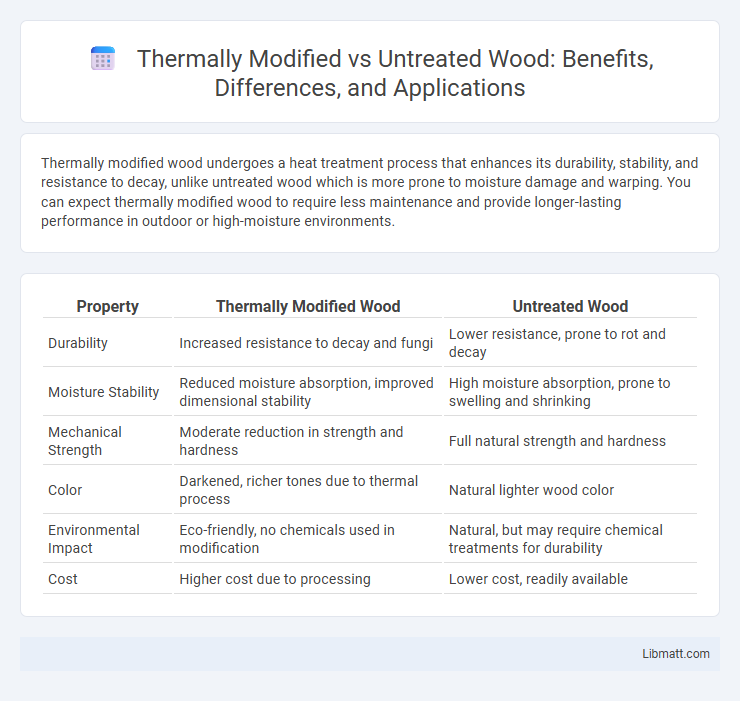Thermally modified wood undergoes a heat treatment process that enhances its durability, stability, and resistance to decay, unlike untreated wood which is more prone to moisture damage and warping. You can expect thermally modified wood to require less maintenance and provide longer-lasting performance in outdoor or high-moisture environments.
Table of Comparison
| Property | Thermally Modified Wood | Untreated Wood |
|---|---|---|
| Durability | Increased resistance to decay and fungi | Lower resistance, prone to rot and decay |
| Moisture Stability | Reduced moisture absorption, improved dimensional stability | High moisture absorption, prone to swelling and shrinking |
| Mechanical Strength | Moderate reduction in strength and hardness | Full natural strength and hardness |
| Color | Darkened, richer tones due to thermal process | Natural lighter wood color |
| Environmental Impact | Eco-friendly, no chemicals used in modification | Natural, but may require chemical treatments for durability |
| Cost | Higher cost due to processing | Lower cost, readily available |
Introduction to Wood Treatment Methods
Thermally modified wood undergoes a high-temperature process that alters its cellular structure, enhancing durability, stability, and resistance to moisture and decay compared to untreated wood. Untreated wood retains its natural properties but is more susceptible to warping, insect damage, and rot over time, especially in outdoor or humid conditions. Your choice between thermally modified and untreated wood depends on the desired longevity and performance for construction or furniture applications.
What is Thermally Modified Wood?
Thermally modified wood undergoes a controlled heat treatment process, elevating its temperature between 160degC to 220degC to improve durability and dimensional stability. This treatment reduces moisture content and alters the wood's chemical structure, making it more resistant to decay, insects, and warping compared to untreated wood. Your choice of thermally modified wood ensures enhanced longevity and environmental sustainability without the need for chemical preservatives.
Understanding Untreated Wood
Untreated wood naturally contains moisture and organic compounds that make it susceptible to decay, insect attacks, and dimensional instability. Understanding untreated wood highlights the importance of moisture management and protective treatments to enhance durability and lifespan. Your choice between untreated and thermally modified wood impacts maintenance requirements and environmental resistance.
Key Differences in Appearance
Thermally modified wood exhibits a darker, richer color compared to untreated wood, often showcasing deep browns and enhanced grain patterns due to heat treatment processes. Untreated wood retains its natural, lighter tone with more visible sapwood and less uniform texture. Your choice of thermally modified wood offers superior aesthetic consistency and resistance to discoloration over time.
Durability Comparison
Thermally modified wood exhibits significantly enhanced durability compared to untreated wood due to its altered chemical structure that increases resistance to decay and insect attacks. The thermal modification process reduces wood's hygroscopicity, minimizing moisture absorption and fungal growth, which are primary factors in untreated wood degradation. Studies show thermally modified wood can last up to three times longer in outdoor applications, making it a superior choice for long-term structural and decorative uses.
Resistance to Moisture and Decay
Thermally modified wood exhibits significantly enhanced resistance to moisture and decay compared to untreated wood due to the reduction of hygroscopic hemicelluloses during heat treatment. This process decreases the wood's equilibrium moisture content, resulting in improved dimensional stability and reduced susceptibility to fungal attacks. Untreated wood absorbs more water, leading to higher risks of swelling, warping, and biological degradation over time.
Environmental Impact and Sustainability
Thermally modified wood offers a significantly lower environmental impact compared to untreated wood due to its enhanced durability, which reduces the need for chemical preservatives and frequent replacement. This modification process increases the wood's resistance to decay and insects, contributing to longer product life cycles and less resource consumption. Untreated wood, while biodegradable, often requires harvesting at a higher rate and may involve chemical treatments that raise environmental concerns.
Maintenance Requirements
Thermally modified wood requires significantly less maintenance compared to untreated wood due to its enhanced resistance to moisture, decay, and insect attacks. Unlike untreated wood, it is less prone to warping, cracking, and fungal growth, which reduces the frequency of sealing, staining, and repairs. These properties extend the lifespan of outdoor structures and lower long-term upkeep costs.
Applications and Best Uses
Thermally modified wood excels in outdoor applications such as decking, siding, and garden furniture due to its enhanced durability, dimensional stability, and resistance to decay compared to untreated wood. Untreated wood remains suitable for indoor uses like furniture, framing, and trim where exposure to moisture and pests is minimal, preserving its natural appearance and workability. Selecting thermally modified wood is optimal for projects requiring longevity and weather resistance, while untreated wood fits cost-sensitive or temporary constructions.
Cost Considerations and Value
Thermally modified wood generally incurs higher upfront costs compared to untreated wood due to its specialized treatment process, which enhances durability and resistance to decay. Despite the increased initial investment, thermally modified wood offers long-term value by reducing maintenance expenses and extending the lifespan of outdoor structures. Untreated wood may be more affordable initially but often requires frequent repairs and replacements, potentially leading to higher total costs over time.
Thermally modified vs untreated Infographic

 libmatt.com
libmatt.com